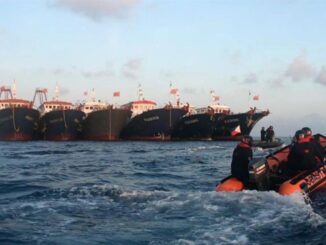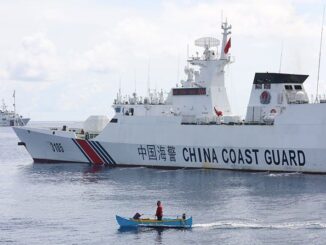
MANILA, Philippines — The Philippines has brushed off China’s latest threat to “crush” foreign incursions in the South China Sea, choosing instead to reaffirm its commitment to peaceful dialogue with Beijing over their maritime dispute.
Alex Lopez, spokesperson of the National Maritime Council, described the statement by the senior Chinese military official as a “general threat” that echoes China’s previous pronouncements.
“It’s a bluff. It’s a narrative intended for the internal audience,” Lopez said in an interview with GMA’s DZBB on Friday, September 13.
Lopez noted that the Chinese senior military official’s warning specifically named the United States as the apparent instigator in the South China Sea, parts of which are called the West Philippine Sea.
“If you look at their threats in general and foreign forces, we can say that it’s not really directed at us, but at America. Their criticism (patutsada) is aimed at them,” Lopez said in mixed Filipino and English.
Amid its escalating maritime row and repeated run-ins with aggressive Chinese vessels, the Philippines continues to hold bilateral talks with Beijing over the conflict without giving up “even a square inch” of its territory, Lopez said.
“Our preparations come in the form of our talks with China. The good thing is that China is also engaging in dialogue,” he said.
After a month of trading accusations over incidents near Escoda (Sabina) Shoal, the Philippines and China held another round of talks on Wednesday where neither side backed down from their territorial claims in the disputed waters.
While the meeting involved a discussion on how to “lower tensions in the area,” the Department of Foreign Affairs said the Philippines also stood firm on its position on Escoda Shoal, a feature located deep within the country’s 200-nautical mile exclusive economic zone.
At the center of the maritime conflict in the waters near Escoda Shoal is one of the Philippine Coast Guard’s biggest vessels, BRP Teresa Magbanua. The vessel has been stationed there since April amid China’s reclamation activities in the area.
Beijing has repeatedly urged the Philippines to tow the ship as it claims its presence violates China’s territorial sovereignty.
For Lopez, the Philippines has “no other legal recourse” but to go to the international court and find allies in the international community.
“China’s continued aggression against Philippine vessels poses a challenge to the international community on how to counter China,” Lopez said.
He also said the Philippine government will “never tire” of filing diplomatic protests against China over its aggressive behavior. This is part of the country’s efforts to assert the 2016 ruling that dismissed China’s sweeping claims in nearly the entire South China Sea.
“We are in a rules-based order, so right is might,” the council spokesperson said.
“The government’s position is that we have sovereign rights and jurisdiction, and whatever the dispute is, we will settle it in the most peaceful manner,” Lopez added.
The Philippines and China struck a “provisional arrangement” in July aimed at de-escalating tensions in the contested waters, specifically during Philippine forces’ resupply missions to BRP Sierra Madre at Ayungin Shoal.
However, experts have warned that this deal is limited only to that specific part of the sea and will give China the impetus to assert its presence elsewhere.





Be the first to comment